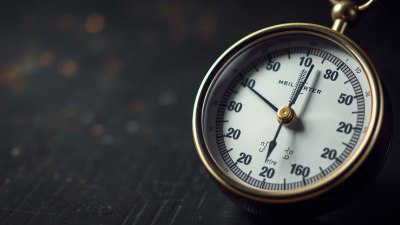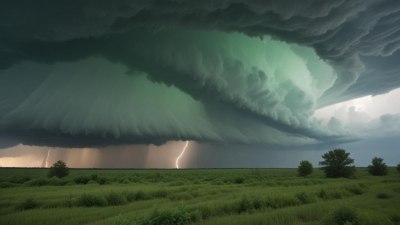What a Barometer Can Teach You About Incoming Weather
Discover how a barometer helps predict weather changes and understand atmospheric pressure for better forecasts.

Image created with Flux Schnell
Understanding the weather is essential for daily planning, outdoor activities, and even safety during extreme conditions. One of the most reliable tools for predicting weather conditions is the barometer, an instrument that measures atmospheric pressure. Despite the prevalence of digital weather forecasts, the barometer remains a fascinating and practical device for understanding incoming weather changes. In this article, we'll explore what a barometer is, how it works, and what it can teach you about the weather that is about to arrive.
The Basics of Atmospheric Pressure
Atmospheric pressure, also known as air pressure, is the force exerted onto a surface by the weight of the air above that surface in the atmosphere of Earth. This pressure is affected by the temperature, altitude, and humidity of the air, contributing to variations that often correspond to changing weather patterns. High atmospheric pressure usually indicates clear, calm weather, while low pressure is often associated with stormy or unsettled conditions.
Since atmospheric pressure changes continually due to the movement of air masses, tracking these variations can provide valuable insights into developing weather systems. This is where the barometer comes into play as a tool to measure these changes precisely.
What Is a Barometer?
A barometer is an instrument designed to measure atmospheric pressure. There are several types of barometers, but the most common ones are mercury barometers and aneroid barometers. In a mercury barometer, atmospheric pressure pushes down on a reservoir of mercury causing it to rise or fall within a glass tube. The height of the mercury column then indicates the atmospheric pressure. Aneroid barometers, on the other hand, use a small, flexible metal box called an aneroid cell that expands or contracts with changes in pressure. This movement drives a needle on a dial to show the current atmospheric pressure.
Both types of barometers provide readings that can be used to predict short-term weather developments.
How Does a Barometer Predict Weather?
Since weather changes are often preceded by shifts in atmospheric pressure, monitoring these shifts can give clues about what kind of weather to expect. When atmospheric pressure drops significantly, it often indicates that a low-pressure system is moving in. Low pressure allows air to rise and cool, leading to cloud formation and precipitation. Therefore, a falling barometer reading usually predicts rain, storms, or windy conditions.
Conversely, a rising barometer reading typically signifies an approaching high-pressure system. High pressure suppresses cloud formation and results in clear, calm, and often sunny weather. A steady barometer reading indicates stable weather conditions.
Reading a Barometer: What to Look For
To use a barometer effectively, it’s important to understand not just the current pressure but also its trend over time. Here are key points to consider:
- Rising Pressure: Indicates improving weather, possibly clearing skies and dry conditions.
- Falling Pressure: Signals deteriorating weather, such as rain, storms, or increased wind.
- Steady Pressure: Suggests that the weather will remain consistent for a while.
- Rapid Pressure Changes: May mean sudden weather changes, and caution should be taken especially during outdoor activities.
By comparing today's reading with previous ones, you can detect trends that predict upcoming weather changes.
Types of Barometers and Their Uses
While mercury barometers were historically common for weather prediction, they are less frequently used today due to mercury's toxicity and portability constraints. Instead, most home and professional weather enthusiasts use aneroid barometers for convenience and safety.
Modern digital barometers have further enhanced weather forecasting. These devices can record precise pressure changes over time and often combine barometric data with temperature and humidity measurements for comprehensive weather monitoring.
Barometers in Everyday Life
Beyond meteorology, barometers play various roles in daily life and other specialized fields. For example:
- Outdoor Activities: Hikers, sailors, and hunters often use barometer readings to anticipate weather changes, which is crucial for safety and planning.
- Aviation: Pilots rely heavily on barometric pressure to determine altitude and anticipate weather conditions for safe navigation.
- Scientific Research: Environmental scientists use barometric pressure data to study climate patterns and understand atmospheric dynamics.
Learning to read a barometer can thus equip you with practical knowledge that extends into multiple areas of life and work.
Barometer Tips for Weather Prediction
If you decide to use a barometer at home, here are some helpful tips to maximize its benefits:
- Place the barometer indoors away from direct sunlight, drafts, and heat sources to ensure accurate readings.
- Check the pressure readings at regular intervals, preferably at the same times each day.
- Note the pressure trend rather than just the current number—this is the most valuable data for weather forecasting.
- Combine barometric readings with visual weather observations, like cloud movement and wind direction, to enhance your predictions.
With practice, you can become adept at interpreting your barometer's signals and anticipate weather changes with confidence.
Limitations of Barometers
While barometers are useful for short-term weather forecasts, they have limitations. Atmospheric pressure alone does not provide a full picture of weather systems, and local geography, temperature, and humidity also influence weather outcomes. Additionally, high-pressure systems can occasionally bring unexpected weather patterns, such as cold snaps or heat waves, that barometric readings alone might not predict accurately.
For complex and long-term forecasting, meteorologists use a combination of tools, including satellite data, radar, and computer models. However, for immediate local weather predictions, barometers remain an indispensable tool.
Historical Importance of the Barometer
The invention of the barometer in the 17th century revolutionized understanding of weather and atmospheric science. Evangelista Torricelli, an Italian physicist, created the first mercury barometer in 1643, enabling the direct measurement of atmospheric pressure for the first time. This breakthrough helped explain why the air exerts pressure and laid the groundwork for modern meteorology.
Over centuries, barometers have evolved from scientific curiosities into practical instruments for everyday use, empowering people to predict weather and make informed decisions.
Modern Innovations in Barometry
Today, barometers are integrated into smartphones, smartwatches, and other portable devices. These sensors provide real-time atmospheric pressure data that support personalized weather apps and activity tracking. For example, fitness trackers can use barometric data to assess elevation changes during hiking or running.
In professional meteorology, barometric data from global networks of sensors help create detailed weather models that improve forecast accuracy worldwide. This integration of traditional measurement techniques with digital technology continues to advance how we understand and prepare for the weather.
How to Choose a Barometer
When selecting a barometer, consider the following factors:
- Type: Choose between aneroid, mercury, or digital based on your needs and preferences.
- Accuracy: Look for calibrated instruments with clear dials or digital precision.
- Design: Home barometers come in decorative styles that can complement your space, from classic brass to modern designs.
- Additional Features: Some barometers include thermometers and hygrometers for comprehensive weather monitoring.
Purchasing from reputable manufacturers ensures reliable performance and durability.
Barometer Maintenance
Proper maintenance ensures your barometer remains accurate over time. Keep mercury barometers stationary and away from cold spots, since temperature affects mercury levels. For aneroid barometers, occasional calibration with a known pressure source maintains precision. Digital barometers often require battery replacement and software updates.
Regular cleaning and careful handling prolong the life of your barometer and guarantee consistent readings.
Understanding Barometric Trends and Weather Patterns
Interpreting barometric data in the context of local weather patterns further enhances forecasting ability. For instance, coastal areas might experience quicker pressure changes due to oceanic influences, whereas mountainous regions may see more variable readings caused by elevation shifts.
Seasonal variations also affect normal pressure ranges, so comparing current readings against seasonal norms can indicate unusual weather developments. Tracking these trends over weeks or months builds intuition about your area's typical patterns.
Practical Applications: Using a Barometer to Stay Safe
Knowing how to read barometric pressure can be lifesaving during extreme weather events. For example, a sudden rapid drop in pressure could warn of an impending severe storm or hurricane. Outdoor enthusiasts can avoid hazardous weather by anticipating these changes early.
Farmers use barometers to plan planting and harvesting based on moisture expectations. Pilots, sailors, and emergency responders rely on accurate pressure readings to make timely decisions. By incorporating barometer knowledge into daily routines, you can enhance preparedness and safety.
Common Misconceptions About Barometers
One common misconception is that barometers predict specific weather conditions with certainty. Instead, barometers indicate changes in air pressure that correlate with weather patterns but do not reveal exact events like rainfall amounts or temperature shifts.
Another misunderstanding is confusing altitude with weather pressure, as higher elevations naturally have lower atmospheric pressure. Barometer readings must be corrected for altitude to provide meaningful weather information.
Learning More About Weather Forecasting
For those interested in deepening their knowledge, combining barometer readings with other meteorological data such as wind direction, temperature, and humidity provides a richer understanding of weather dynamics. Resources including local weather station data, online tutorials, and meteorology courses can enhance your predictive skills.
Many weather enthusiasts enjoy creating personal weather stations that integrate barometers, thermometers, and rain gauges, creating a hands-on approach to studying local climate variations.
A barometer is a powerful yet accessible tool for predicting short-term weather changes. By measuring atmospheric pressure and observing its trends, users can anticipate shifts in weather conditions, from clear skies to storms. Its applications span outdoor activities, aviation, agriculture, and scientific research. Despite modern technological advances, the barometer remains a vital instrument that connects us to the fundamental forces shaping our atmosphere.
Mastering barometer use enriches your understanding of the natural world and improves your ability to respond effectively to changing weather.











